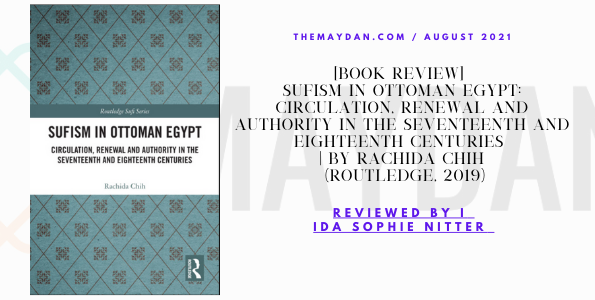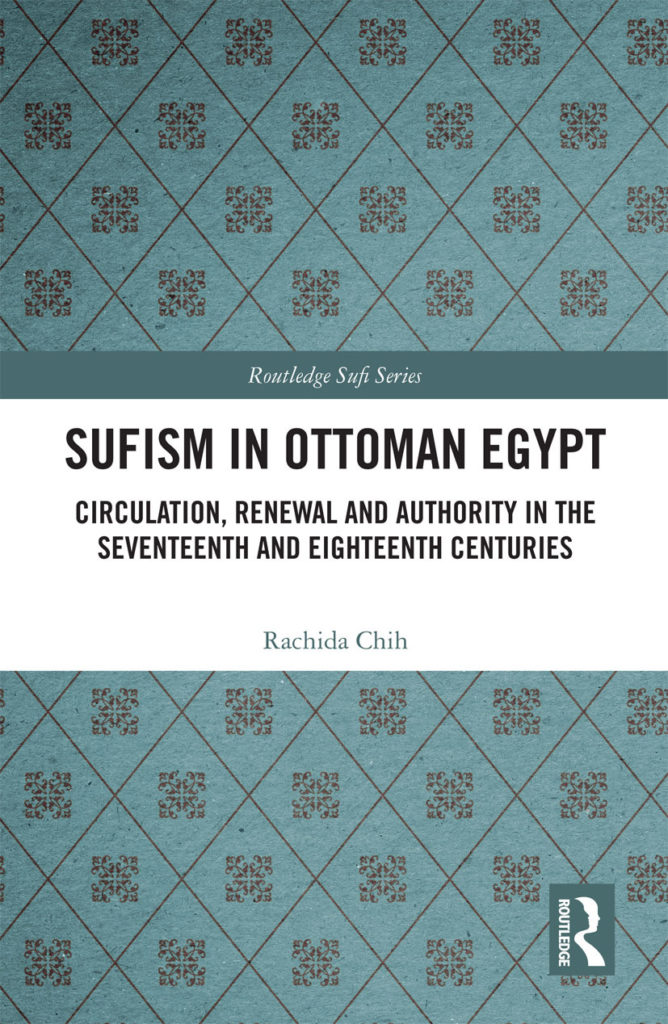
Rachida Chih, Sufism in Ottoman Egypt: Circulation, Renewal and Authority in the Seventeenth and Eighteenth Centuries (New York: Routledge, 2019). 180pp., $39.16 (paperback), ISBN: 9780367730451 | Reviewed by Ida Sofie Nitter
“The university was where students received their initiation into Sufism. … some of these affiliations were to foreign masters who had settled in Cairo, but primarily and above all they were to Egyptians, masters and professors at al-Azhar” (32). This quotation succinctly summarizes the core argument of Rachida Chih’s Sufism in Ottoman Egypt; namely, that professors at the University of Azhar – arguably the most important Sunni religious educational institution at the time – played a key role in initiating students into Sufi Orders. As Chih shows, numerous Sufi shaykhs in seventeenth and eighteenth century Cairo were highly esteemed professors of Islamic Sciences and ‘ulamā’ in their own right. Thus, these Sufis were “well versed in the other sciences of Islam – jurisprudence, theology, Quranic exegesis and even belles-lettres” (10). They thereby represented “the figure of the ideal scholar” at the time, as thinkers who “brought together the exoteric and esoteric sciences” (10).
For seventeenth and eighteenth century students of al-Azhar, intellectual pursuits were often accompanied by an initiation into the world of Sufi orders. In addition to studying Islamic Sciences with their shaykhs at al-Azhar, many students would gather with the same ‘ulamā’ for spiritual gatherings and become their disciples. These ‘ulamā’ were “considered to be holy men whose protection (which was of a divine nature) it was imperative to seek” (7). Although numerous Sufi orders were present in Egypt in the late Ottoman period, the Khalwatiyya Order was of special importance at al-Azhar. As students came to Cairo from the provinces around Egypt to study at al-Azhar, they returned with the spiritual teachings of their masters, sometimes having become spiritual guides themselves. Chih argues that al-Azhar thereby became a catalyst of Sufi teachings, particularly those of the Khalwatiyya order, and facilitated the spread of this order throughout Egypt.
“‘The university was where students received their initiation into Sufism. … some of these affiliations were to foreign masters who had settled in Cairo, but primarily and above all they were to Egyptians, masters and professors at al-Azhar’ (32). This quotation succinctly summarizes the core argument of Rachida Chih’s Sufism in Ottoman Egypt; namely, that professors at the University of Azhar – arguably the most important Sunni religious educational institution at the time – played a key role in initiating students into Sufi Orders.”
The book consists of four main chapters: 1) Circulation and Networks: The Role of Cairo and Al-Azhar; 2) Education: How to Guide Disciples?; 3) The Muhammadan Path and Sufi Renewal; and 4) Prophetic Heritage, Authority and the Intercession of Saints. The first chapter, “Circulation and Networks: The Role of Cairo and Al-Azhar” in my view contains the essential argument of the book: that al-Azhar played a prominent role in the dissemination of Khalwatī teachings and the Khalwatiyya order in Egypt.
“Rachida Chih argues that the arrival of the Khalwatī shaykh Mustafā al-Bakrī in Cairo in the beginning of the eighteenth century marked ‘a turning point in the history of Sufism in Egypt’ (28), and that his successor Muhammad al-Hifnī, when he became the eighth Shaykh of al-Azhar – head of the university – in 1757 helped spread the Khalwatiyya across all of Egypt (31)”
Rachida Chih argues that the arrival of the Khalwatī shaykh Mustafā al-Bakrī in Cairo in the beginning of the eighteenth century marked “a turning point in the history of Sufism in Egypt” (28), and that his successor Muhammad al-Hifnī, when he became the eighth Shaykh of al-Azhar – head of the university – in 1757 helped spread the Khalwatiyya across all of Egypt (31). Shaykh al-Hifnī managed this through “his allegiance of a large number of aspirants” and the dhikr sessions he held “around the clock.” According to Chih, Shaykh al-Hifnī had so many disciples at al-Azhar that “belonging to this path became synonymous with belonging to the azharī institution, and to a milieu that was urban, cosmopolitan and educated” (32). The connection between the azharī elite and the Khalwatiyya order remained prominent, and until the end of the nineteenth century nine different Khalwatī shaykhs held the position of Shaykh of al-Azhar (34). In addition to Shaykh al-Hifnī, Rachida Chih points out one other shaykh – Shaykh Ahmad al-Dardīr – as being responsible for much of the dissemination of the Khalwatiyya order to Upper Egypt. Al-Dardīr held the position as Shaykh of the college (riwāq) of students from Upper Egypt at al-Azhar, and he naturally took on many of these students as his disciples in the Khalwatiyya Order (35).
Rachida Chih raise two important points regarding Sufi practices and affiliations that may seem counter to the information just provided. First, despite the strong connection between al-Azhar and the Khalwatī Order, she is careful to point out that most of these spiritual gatherings took place outside of the university premises, such as in the homes of the shaykhs. This was because “the transmission of Sufism, as with the other religious sciences, was not attached to an institution, but to a spiritual master at the centre of a larger or smaller circle of disciples” (19). It was sitting in the company of the shaykh and learning from the shaykh that was of utter importance, not his location. Second, many disciples in Sufi orders had multiple affiliations (25). For example, when Shaykh al-Hifnī established the Khalwatiyya at al-Azhar the Shādhiliyya was already a very important order amongst the ‘ulama’ in Egypt. Many scholars combined these two paths “in their collections of chains of spiritual transmission” (22).
In the second chapter, “Education: How to Guide Disciples?” Rachida Chih analyzes three Sufi handbooks from the Khalwatī order: Al-Sayr wa-l-sulūk ilā malik al-mulūk (Spiritual Wayfaring and the Journey towards the King of Kings) by Qāsim al-Khānī (d. 1697) and two handbooks based on al-Khānī’s work written by Muhammad al-Murnīr al-Samanūdī (d. 1785) and Ahmad al-Dardīr (d. 1786). This chapter demonstrates how the Khalwatī order trained their disciples, and the trials the latter had to go through to raise in ranks within the order. It also establishes the growing importance of handbooks written by Sufi guides for the novice (51). Whereas Khānī’s treatise outlines a “complex scheme of psycho-spiritual states,” Samanūdī and Dardīr’s handbooks are written as “practical guides, focusing almost exclusively on the rules governing the recitations of the Khalwatiyya’s own wird, the collective practice of the dhikr, and the social behaviour of the disciple” (53). Apart from being guides for Khalwatīs, these handbooks provided general advice “on individual conduct and social etiquette for all Muslims” (72).
The third chapter, “The Muhammadan path (tarīqa Muhammadiyya) Sufi renewal,” shows how “Sufis laid claim to a Prophetic heritage through the concept of a Muhammadan path, as well as the specific doctrinal, social and political developments to which such claims led” (78). A large portion of this chapter is a historiographical section explaining scholarly debates around the concept of neo-Sufism (a concept now left by most academics discussing modern Sufi orders) as well as other new approaches in the academic study of Sufism – a section of use to students of the field, but of lesser interest to the general reader. Chih concludes the section by arguing that “nothing in the doctrinal content of Sufism had changed between earlier periods and the time in question” and that there were numerous elements of “continuity between medieval and modern Sufism” (85). Thus, although one may be tempted to think of the arrival of the Khalwatiyya in Egypt as a major rupture and reform, “the Egyptian Khalwatiyya was not a new Sufi path, born as it was from the Turkish Khalwatiyya, the essential principles of which it conserved” (95).
Finally, in chapter 4, “Prophetic heritage, authority and the intercession of saints,” Rachida Chih explains the ways Sufis categorize believers in a hierarchy, distinguishing between “the ordinary believers (‘āmma), the spiritual elite (khāssa) and the elite within the elite (khāssat al-khāssa)” and by extension discusses how Sufi saints were understood vis-à-vis ordinary Muslims (111). Chih also use this chapter to explain why people followed Sufi shaykhs. Based on her readings of hagiographical sources, Chih argues that people submitted to a saint for his “baraka, the divine blessing befitting those who had journeyed towards God and then returned from Him to guide, support and intercede for humankind” (111).
Though the title of this book implies that it is a general study of Sufism in late Ottoman Egypt, it focuses on the Khalwatiyya order. This Order was indeed of great importance in Egypt in the seventeenth and eighteenth centuries, yet it was still only one of many Sufi orders present in Egypt at the time. The role the Khalwatiyya played was remarkable precisely because of its importance within al-Azhar and how that facilitated the dissemination of ideas and practices. However, based on the book’s structure and focus, a reader with little knowledge about Sufism in modern Egypt may assume that the Khalwatiyya was the only Sufi order of any real importance, or that all Sufi practices – processes of initiation, advancement within the order, dhikrs etc. – mirror those of the Khalwatiyya, but that is not the case. As shown above Chih does highlight the importance of the Shadhiliyya Order and points out that “there are as many spiritual methods as there are Sufi paths” when describing Khalwatī practices” (51). Yet, because of the overwhelming focus on the Khalwatiyya, I fear that these nuances may get lost on the non-expert reader.
“Though the title of this book implies that it is a general study of Sufism in late Ottoman Egypt, it focuses on the Khalwatiyya order. This Order was indeed of great importance in Egypt in the seventeenth and eighteenth centuries, yet it was still only one of many Sufi orders present in Egypt at the time.”
Despite the very central role Sufi Orders and Sufi practices have played in Egypt throughout the centuries, very little has been written in English about Sufi practices in the post-Medieval period,[1] and the studies that have been written often focus primarily on the political and social role of Sufi orders. As such, this book is a much-needed contribution not only to the field of Sufi studies, but to the field of modern Egyptian history generally. I would recommend the book in its entirety to any scholar of Sufism in the modern era and scholars of modern Egypt. Further, I think Chapter 1 in particular is clear, comprehensive and accessible to non-experts, and I would recommend it for undergraduate and graduate seminars in these fields as well.
Ida Sofie Nitter is a PhD Candidate at the University of Pennsylvania. Her dissertation focuses on tasawwuf (Sufsm) in 18th and 19th century Cairo, and the religious practices associated with tasawwuf, including the celebration of mawlids, tomb visitation, and the use of litanies. Nitter is passionate about what religious practice and Islam looked like in Cairo in the early modern and modern period across social and economic divides. She hopes to provide a counterweight to the heavy focus on Islamic Modernism that has gained in Western academia’s study of modern Egyptian history.
[1] Rachida Chih and other French scholars have published much more on Sufism in modern Egypt, but these studies are unfortunately often overlooked in the English-speaking academy.


